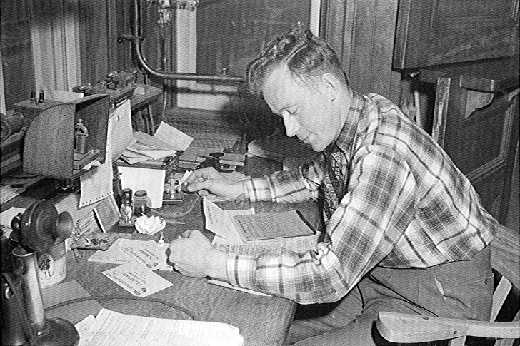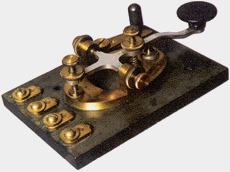 |
Summer 2006
|
Morse Telegraphy is Still Alive
by Lavina G. Shaw - Morse Telegraph Club

All railway station agents
were expected to be proficient in the art of Morse code.
Although Morse code isn't used in train
dispatching any more, other than in Ecuador and perhaps other third world countries, the code is kept
"alive" by members of the Morse Telegraph Club.
The advent of telegraphy brought about huge changes in railroading. Before the telegraph, trains often waited for
hours in sidings to meet other trains coming in the opposite direction. When telegraphy was adopted in the late 1830s,
a train dispatcher would contact a station agent or operator who would deliver a written train order to the conductor
and the engineer.
 Members of the Morse Telegraph Club are trying to promote the heritage of the Morse code and the part telegraphy
played in the movement of trains and communication. Club members have assisted in furnishing and installing telegraph
equipment in many museums, particularly those located in heritage railway stations. They have provided audio
telegraph train orders for model railroads, and regularly take part in demonstrations of the telegraph at pioneer
fairs, historical re-enactments, model railroad shows, and other special events.
Members of the Morse Telegraph Club are trying to promote the heritage of the Morse code and the part telegraphy
played in the movement of trains and communication. Club members have assisted in furnishing and installing telegraph
equipment in many museums, particularly those located in heritage railway stations. They have provided audio
telegraph train orders for model railroads, and regularly take part in demonstrations of the telegraph at pioneer
fairs, historical re-enactments, model railroad shows, and other special events.
To keep their skills, the club has two "hubs" which telegraphers can access through their telephone lines
and, with the use of a modem, chat in Morse code with up to seven other telegraphers. One hub, which has a free
1-888 number is located in Toronto, while the other is located at the Steam Railroad Museum in Owosso,
Michigan. At any time of the day, you can dial in and hear telegraphers chatting from Alaska, Florida, Nova Scotia,
and any number of locations in between.
Conservations over the hub often are reminiscent of the days when telegraphers worked on the railroad, and many a
story is told of train wrecks or humorous incidents that happened in railway stations.
After the Second World War, Centralized Traffic Control (CTC) and computers gradually displaced dispatching by
telegraph. It is said that the last train order sent by telegraph in the U.S. and Canada was in the mid 1980s.
The Morse Telegraph Club has tapped into the modern age. A training program called "The Mill" instructs
students in both the American Landline code (used by the railways) and the International code (used by ham radio
operators, ships, and the armed forces). It can be downloaded free. Another program has been developed that can send
Morse code by computer.
The club, with 32 chapters scattered throughout North America, publishes a quarterly newsletter filled with many
railway-related stories. It seems that there is a never-ending supply of "rail
tales" from days gone by.
The club welcomes new members. If you are a former telegrapher, or are just interested in helping to preserve the
heritage of telegraphy, you may contact me at lshaw@telus.net, or write
to 112-2357 Whyte Avenue Port Coquitlam BC Canada V3C 2A3.
Morse Telegraph Club
This Canadian Pacific Spanner article
is copyright 2006 by the Canadian Pacific Railway and is reprinted here with their
permission. All photographs, logos, and trademarks are the property of the Canadian Pacific Railway
Company.
|